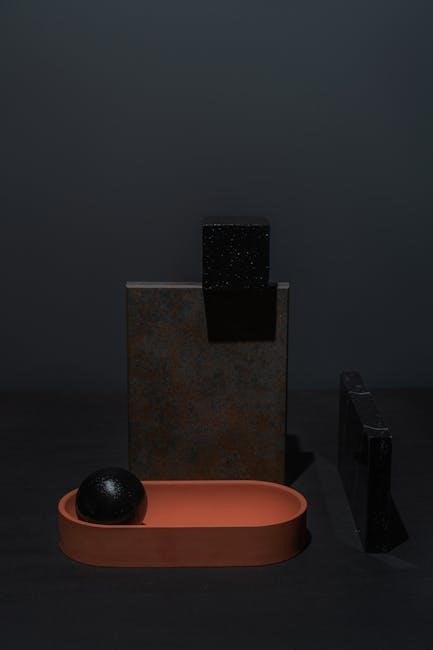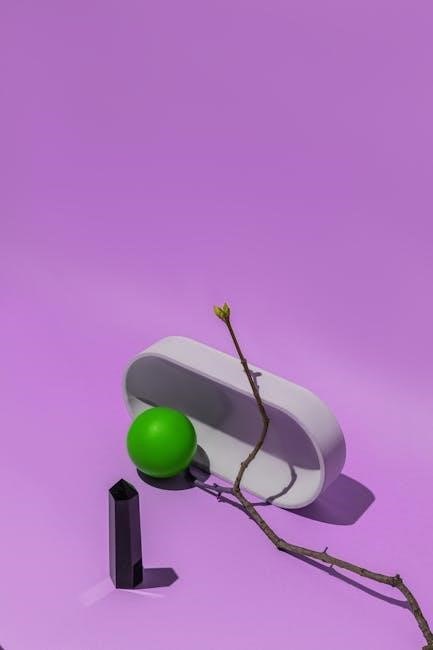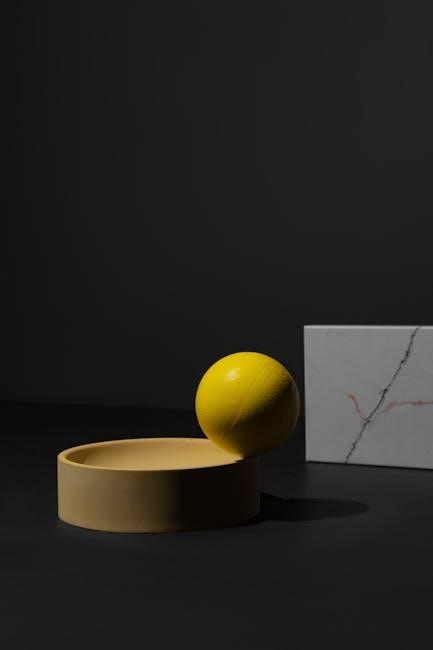Definition and Overview
Composite figures are shapes formed by combining simpler shapes like rectangles, triangles, and circles. They help break complex problems into manageable parts for easier calculations.
Importance of Understanding Composite Figures
Mastering composite figures enhances spatial reasoning and problem-solving skills, essential for math and real-world applications like architecture and design. They build confidence in tackling complex geometry.
Composite figures are shapes made up of two or more simpler shapes, such as rectangles, triangles, and circles. These figures are used to simplify complex area calculations by breaking them into manageable parts. The process involves identifying individual shapes within the composite figure and calculating their areas separately. This method is particularly useful for irregular shapes that cannot be measured using standard formulas directly. By understanding composite figures, students develop essential problem-solving skills and spatial reasoning. Worksheets and PDF resources provide practical exercises to practice breaking down and calculating areas, making learning interactive and effective. Composite figures are fundamental in math education, preparing students for real-world applications in design, architecture, and engineering.
Understanding composite figures is crucial for developing strong problem-solving and spatial reasoning skills. These figures teach how to break complex shapes into simpler, manageable parts, making area calculations more straightforward. This skill is invaluable in real-world applications, such as architecture, design, and engineering, where irregular shapes are common. By mastering composite figures, students build a foundation for tackling advanced geometry and applied math. Worksheets and PDF resources provide hands-on practice, helping learners apply theories to practical problems. Grasping this concept enhances critical thinking and prepares individuals for careers requiring precise measurements and creative problem-solving. Composite figures are a stepping stone to more complex mathematical challenges, fostering confidence and analytical abilities.
Key Concepts for Calculating Areas
Breaking shapes into simpler parts, like rectangles and triangles, simplifies area calculations. Using formulas for each part and combining or subtracting areas ensures accuracy.
Breaking Down Composite Shapes
Composite shapes can be divided into simpler components like rectangles, triangles, and circles. Start by identifying these individual shapes within the composite figure. Once identified, calculate the area of each shape separately using their respective formulas. For rectangles, use length × width; for triangles, use (base × height) ÷ 2; and for circles, use π × radius². After calculating the areas of each individual shape, combine them to find the total area of the composite figure. If there are overlapping or missing sections, adjust by adding or subtracting the areas accordingly; This method ensures accuracy and simplifies complex area calculations effectively.
Identifying Constituent Shapes (Rectangles, Triangles, Circles)
In composite figures, constituent shapes like rectangles, triangles, and circles are the building blocks. Rectangles are identified by their right angles and opposite sides of equal length. Triangles are recognized by their three sides and angles, with right, acute, or obtuse variations. Circles are perfect round shapes with all points equidistant from the center. When analyzing a composite figure, start by sketching or visualizing how these shapes fit together. Look for straight edges for rectangles, angular points for triangles, and curved lines for circles. Accurately identifying these components is crucial for breaking down the figure and calculating its total area effectively. This skill enhances problem-solving abilities in geometry and real-world applications.
Using Formulas for Area Calculation
Mastering area formulas is essential for solving composite figure problems. For rectangles, the area is calculated as length × width. Triangles require ½ × base × height, while circles use π × radius². When working with composite shapes, break them into these simpler forms. Apply each formula to the individual components, ensuring accurate measurements. For example, if a composite figure includes a rectangle and a triangle, calculate their areas separately and sum them. If a circle is part of the figure, use the radius to find its area. Properly applying these formulas ensures precise results. Practice with worksheets helps build confidence and skill in handling various composite shapes effectively.

Step-by-Step Guide to Solving Composite Figure Problems
Start by identifying and separating the figure into simpler shapes like rectangles, triangles, and circles. Calculate the area of each individual shape using their respective formulas. Combine these areas to find the total, adjusting for any overlaps or gaps as needed. This systematic approach ensures accuracy and simplifies complex problems.
Step 1: Identify and Separate Individual Shapes
Begin by carefully analyzing the composite figure to identify its constituent shapes, such as rectangles, triangles, circles, and trapezoids. Use visual inspection or grid paper to outline each shape clearly. Pay attention to lines, angles, and curves that define the boundaries of simpler forms within the complex figure. Label each identified shape to keep track of them. This step is crucial as it lays the foundation for accurate area calculation. Overlaps or gaps between shapes should also be noted, as they may require adjustments later. By breaking down the figure systematically, you ensure that no part is overlooked, making subsequent calculations more manageable and precise.
Step 2: Calculate the Area of Each Shape
Once the individual shapes are identified, calculate the area of each using their respective formulas. For rectangles, use length × width. For triangles, it’s (base × height) ÷ 2. Circles require π × radius², using 3.14 for π. Trapezoids use (sum of parallel sides) × height ÷ 2; Ensure all measurements are in the same units before computation. Double-check calculations to avoid errors. For irregular shapes, break them into smaller, manageable parts. Record each area separately for clarity. This step is essential for accurately summing the areas in the next step. Pay attention to any overlapping sections, as they may require adjustment later.
Step 3: Combine Areas for the Total
After calculating the area of each individual shape, sum them up to find the total area of the composite figure. For example, if the composite shape consists of a rectangle and a triangle, add their areas together. Ensure all areas are in the same unit of measurement before combining. If any sections overlap or are subtracted, adjust the total accordingly. Double-check your additions to avoid errors. This step provides the final area of the composite figure, giving a complete understanding of its size. Properly combining areas ensures accuracy in real-world applications like architecture or land measurement.
Step 4: Adjust for Overlapping or Missing Sections
After calculating the areas of individual shapes, check for any overlapping or missing sections. Overlaps occur when shapes intersect, requiring subtraction of the overlapping area to avoid double-counting. Missing sections, such as cutouts, also need to be subtracted from the total area. Use visual inspection or formulas to identify these areas. For example, if two rectangles overlap, calculate the overlapping region’s area and subtract it from the total. Similarly, if a part of the composite figure is missing, determine its area and deduct it. This step ensures the final area reflects the exact size of the composite shape. Accurate adjustments are crucial for precise results in real-world applications like architecture or design.

Common Composite Shapes and Their Properties
Composite shapes often consist of rectangles, triangles, circles, and trapezoids. These primary shapes combine to form complex figures, allowing for simplified area calculations and practical applications.
Rectangles and Their Area Calculations
Rectangles are fundamental components in composite figures, often serving as the building blocks for more complex shapes. Their area is calculated using the formula: length × width. For example, a rectangle measuring 5 meters by 3 meters has an area of 15 square meters. Understanding rectangles is crucial for breaking down composite figures into simpler parts. They provide a clear, structured base for calculating total areas, especially when combined with other shapes like triangles or circles. Worksheets often include rectangles to help students practice area calculations, ensuring a solid foundation for tackling more intricate composite shapes. Mastering rectangles enhances overall proficiency in geometry and problem-solving.
Triangles and Their Role in Composite Figures
Triangles are essential components in composite figures, often used alongside rectangles and circles to form complex shapes. Their area is calculated using the formula: ½ × base × height. Triangles are versatile, allowing for various configurations within composite figures. They can be right-angled, equilateral, or isosceles, each offering unique properties for area calculations. In worksheets, triangles are frequently combined with other shapes to challenge problem-solving skills. For instance, a composite figure might consist of a rectangle with a triangular section added or subtracted. Understanding triangles enhances the ability to break down and analyze complex shapes, making them a fundamental part of geometry. Accurate measurement of base and height is crucial for precise area calculations.
Circles and Their Integration into Composite Shapes
Circles are commonly incorporated into composite figures, adding curved elements to otherwise angular shapes. Their area is calculated using the formula πr², where r is the radius. In worksheets, circles may be combined with rectangles and triangles to form intricate designs. For example, a composite shape might feature a circular section attached to a rectangular base. Circles can also be subdivided into sectors or semicircles, further enhancing their versatility. Understanding the properties of circles, such as diameter and circumference, aids in accurately determining their area within composite figures. This integration challenges students to apply multiple geometric concepts, improving their problem-solving abilities and grasp of spatial relationships.
Trapezoids and Other Irregular Shapes
Trapezoids, with their unique combination of two parallel sides, add complexity to composite figures. Their area is calculated using the formula: ((a + b)/2) * h, where a and b are the lengths of the parallel sides, and h is the height. Other irregular shapes, such as pentagons or hexagons, often require breaking them into simpler components like triangles or rectangles. In worksheets, these shapes may be combined with circles or trapezoids to create challenging problems. The ability to identify and calculate the areas of these irregular shapes is crucial for mastering composite figures. Practice with various configurations helps develop problem-solving skills and attention to detail, ensuring accurate calculations even in complex scenarios.

Real-World Applications of Composite Figures
Composite figures are essential in architecture for designing complex structures, in land measurement for calculating irregular areas, and in art for creating intricate designs and patterns.
Architecture and Design
In architecture, composite figures are crucial for designing complex structures. By breaking buildings into simpler shapes, architects can calculate areas, estimate materials, and plan layouts efficiently. This technique is especially useful for irregularly shaped buildings or unique designs. For example, a skyscraper’s floor plan might combine rectangles and triangles to create a functional yet aesthetically pleasing space. Understanding composite figures allows architects to visualize and execute intricate designs, ensuring accuracy and cost-effectiveness. This skill is also vital for interior designers when calculating spaces for furniture or decor. The ability to decompose complex shapes into manageable parts is a cornerstone of modern architectural practice, enabling creativity and precision in construction projects. Composite figures worksheets help students and professionals alike master these essential skills.
Land Measurement and Surveying
Land measurement and surveying often involve calculating areas of irregular plots, which can be efficiently done using composite figures. By breaking down complex shapes into simpler components like rectangles and triangles, surveyors can accurately determine property boundaries and sizes. This method is essential for tasks such as estimating land value, planning development, and resolving boundary disputes. Composite figures worksheets provide practical exercises for mastering these calculations, ensuring precision in real-world applications. For instance, a plot of land with uneven edges can be divided into recognizable shapes, allowing for accurate area computation. This skill is vital for professionals in surveying, as it ensures reliable data for legal and financial purposes. Composite figures simplify the process of measuring and understanding land spaces effectively.
Art and Craft Projects
Composite figures are a valuable tool in art and craft projects, enabling creators to design intricate and visually appealing designs. By breaking down complex shapes into simpler components like rectangles, triangles, and circles, artists can craft mosaics, patterns, and collages with precision. This skill is particularly useful in projects where fitting different shapes together seamlessly is essential. Composite figures worksheets provide a practical way to master these techniques, allowing artists to experiment with proportions and layouts. Whether creating stained glass art or paper cutouts, understanding composite figures enhances creativity and accuracy. These exercises also inspire innovation, helping crafters to visualize and execute their ideas more effectively.

Practical Worksheets and Resources
Downloadable PDF worksheets on composite figures offer engaging exercises and word problems, complemented by interactive quizzes and comprehensive answer keys for effective learning and practice.
Downloading Composite Figures Worksheets in PDF Format
Downloadable PDF worksheets on composite figures offer a convenient way to practice area calculations. These resources typically include 15+ engaging word problems, answer keys, and interactive quizzes. Designed for Grades 6-8, they cover various levels of difficulty, allowing students to progress at their own pace. Worksheets often feature shapes made up of rectangles, triangles, and circles, with options to add or subtract areas. Units of measurement are customizable, catering to different educational standards. Many worksheets also include visual aids, such as grids, to help students accurately estimate and calculate areas. PDF formats ensure easy printing and sharing, making them ideal for classroom or homeschool use. They align with curriculum requirements, providing a structured approach to mastering composite figures.
Interactive Quizzes for Reinforcement
Interactive quizzes are an excellent way to reinforce learning and assess understanding of composite figures. Available in PDF format, these quizzes often accompany worksheets and provide immediate feedback. They cover topics like calculating areas of rectangles, triangles, and circles within composite shapes. Many quizzes include multiple-choice questions, fill-in-the-blank exercises, and visual problems to test spatial reasoning. Designed for different difficulty levels, they cater to students progressing at their own pace. Interactive quizzes also offer the flexibility to be completed online or printed for traditional assessment. Teachers and students can use them to track progress and identify areas needing further practice. These resources are invaluable for reinforcing problem-solving skills and ensuring mastery of composite figures.
Answer Keys and Solution Guides
Answer keys and solution guides are essential resources for students and educators working with composite figures worksheets. These tools provide detailed explanations and step-by-step solutions for each problem, ensuring clarity and understanding. Solution guides often include visual breakdowns of composite shapes, showing how to divide them into simpler components like rectangles, triangles, and circles. Answer keys not only confirm whether answers are correct but also highlight common mistakes to avoid. Many PDF worksheets include answer keys at the end, making it easy to review work. Solution guides are particularly useful for complex problems, offering insights into alternative methods and reinforcing mathematical concepts. They empower learners to identify areas for improvement and build confidence in tackling composite figure challenges.

Advanced Techniques for Complex Composite Figures
Advanced methods include using grid paper for precise measurements and handling multiple overlapping shapes. These techniques enhance accuracy and simplify solving intricate composite figure problems effectively.
Estimating Areas Visually
Estimating areas visually involves approximating the size of composite figures by breaking them into simpler shapes. This technique is useful when exact measurements are unavailable. By identifying rectangles, triangles, or circles within the figure, you can estimate their dimensions and calculate approximate areas. For irregular shapes, compare them to known areas or use grid paper to visually measure lengths and widths. Rounding dimensions to the nearest whole number simplifies calculations. For circles, estimate the diameter and use π (3.14) to find the area. Practice with worksheets helps improve accuracy. Visual estimation is a practical skill for real-world scenarios, such as estimating material needs or understanding spatial relationships. It enhances problem-solving abilities and mathematical intuition.
Using Grid Paper for Accuracy
Grid paper is a valuable tool for accurately calculating the area of composite figures. By drawing the shape on grid paper, you can break it into simpler shapes like rectangles and triangles. Each square on the grid represents a known area, allowing precise measurements. Counting full squares gives exact areas, while partial squares can be estimated. This method is especially helpful for irregular shapes or when exact dimensions are unknown. Grid paper also aids in visual estimation by providing a structured approach to breaking down complex figures. Regular practice with grid paper enhances spatial reasoning and improves accuracy in area calculations. It is a practical resource for students and professionals alike, ensuring precise results in geometry and real-world applications.
Handling Multiple Overlapping Shapes
Handling multiple overlapping shapes in composite figures requires careful analysis to avoid double-counting or missing areas. Start by identifying each individual shape and its dimensions. Use grid paper to visually separate overlapping sections or apply formulas like the principle of inclusion-exclusion. For example, if two circles overlap, calculate their individual areas and subtract the overlapping region. This ensures accuracy in complex configurations. Practice worksheets with overlapping shapes help refine these skills. Regular exercises build confidence in tackling multi-layered composite figures, enhancing problem-solving abilities and attention to detail. Mastering this technique is crucial for advanced geometry and real-world applications where precise area calculations are essential.
Mastering composite figures enhances problem-solving and spatial reasoning. Regular practice with worksheets and real-world applications ensures confidence. Keep exploring and refining your skills for better understanding and accuracy.
Best Practices for Mastering Composite Figures
To excel in composite figures, start by breaking complex shapes into simpler components like rectangles and triangles. Use grid paper to enhance accuracy and visualize divisions clearly. Regular practice with downloadable PDF worksheets helps reinforce skills. Begin with basic shapes and gradually tackle more intricate designs. Apply real-world contexts, such as calculating areas for painting or farming, to deepen understanding. Always double-check calculations and consider alternative methods to verify results. Engage with interactive quizzes to test knowledge and identify areas for improvement. By following these practices, learners can build a strong foundation and approach composite figure problems with confidence and precision.
Encouraging Problem Solving and Critical Thinking
Engaging with composite figures fosters strong problem-solving abilities and critical thinking. Students learn to analyze complex shapes, breaking them into simpler forms. This skill enhances spatial reasoning and logical deduction. Using worksheets and interactive tools, learners can explore real-world applications, such as estimating painting areas or determining chicken capacity. Encouraging exploration of multiple methods to solve problems builds resilience and adaptability. By tackling diverse composite figures, students develop a deeper understanding of geometry and its practical uses, preparing them for advanced mathematical challenges and fostering a mindset of innovation and creativity.
